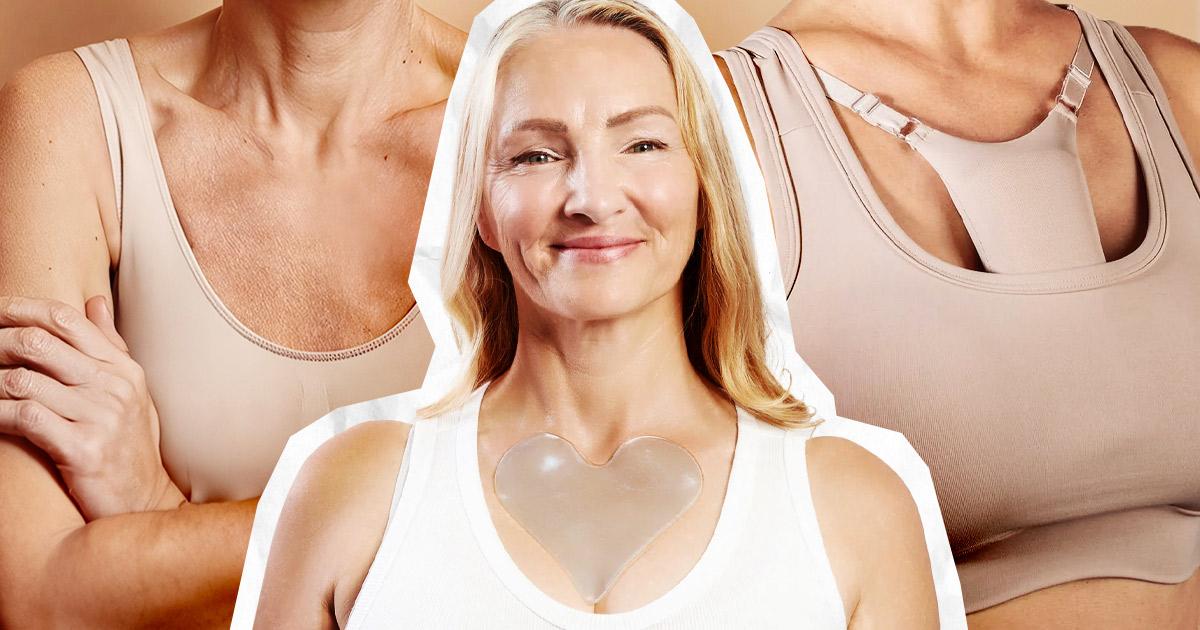What Are The Chest Wrinkle Treatment Options Available To You?

Chest wrinkles, often referred to as cleavage rhytides or décolletage wrinkles, can be a cause of concern for many individuals. As a prominent area of the body, the upper chest plays a significant role in one’s overall appearance. Wrinkles on the chest can detract from a youthful look and lead to self-consciousness. While aging is a natural process, understanding the causes of chest wrinkles and exploring available treatment options can empower individuals to take control of their skin health and maintain a smooth and rejuvenated décolleté.
What is a Chest Wrinkle?
Chest wrinkles are creases that develop on the upper chest, extending between the neck and upper abdomen. These wrinkles, ranging from fine lines to deeper furrowed creases, can originate as dynamic lines due to body movements and positions, such as side sleeping. Over time, these dynamic lines can become more persistent and noticeable even at rest. Collagen and elastin, the proteins responsible for skin structure, firmness, and elasticity, play a crucial role in the development of chest wrinkles.
What Causes Chest Wrinkles?
Chest wrinkles are a result of a combination of factors, each contributing to the breakdown of the skin’s structure and the formation of creases on the décolleté. Understanding these underlying causes can help individuals make informed decisions about treatment and prevention strategies:
- Genetics – Genetic predisposition plays a significant role in the development of chest wrinkles. Inherited genes dictate the baseline production of collagen and elastin, the proteins crucial for skin firmness and elasticity. Additionally, genetic factors influence the rate at which these proteins degrade over time. If chest wrinkles run in your family, you might be more susceptible to developing them.
- Natural Aging – As people age, chest wrinkles can emerge due to the natural aging process. As time passes, the skin’s production of collagen and elastin naturally decreases, causing a decline in skin elasticity and firmness. Genetic factors interact with the aging process, determining the timing and severity of chest wrinkles.
- Sun Exposure – Overexposure to UV radiation from the sun or tanning beds is a major contributor to chest wrinkles. Ultraviolet rays produce harmful free radicals that harm collagen and elastin fibers within the skin. This harm compromises the skin’s supportive framework and speeds up wrinkle development. Extended, unshielded sun exposure can result in early skin aging, intensifying the visibility of chest wrinkles.
- Weight/Volume Changes – Significant fluctuations in weight or changes in chest volume can contribute to the development of chest wrinkles. When the chest area expands due to weight gain, pregnancy, or breastfeeding, the skin is stretched. Subsequent weight loss or volume reduction can lead to excess skin and a loss of elasticity, resulting in wrinkling of the chest area.
- Tobacco Smoking – Smoking is a harmful habit that impacts skin health and accelerates the aging process. Smoking subjects the skin to harmful substances and free radicals, causing harm to collagen and elastin fibers. Moreover, smoking reduces blood flow and oxygen delivery to the skin, impairing the body’s natural healing and repair mechanisms. Those who engage in smoking are prone to encountering premature chest wrinkles and accelerated skin aging.
- Side Sleeping – Sleeping on one’s side, especially for those with larger breasts, can lead to the development of chest wrinkles. Gravity causes the breasts to press against the chest, leading to the formation of vertical creases. As time progresses, these folds can grow more prominent and conspicuous, adding to the development of chest wrinkles.
- Poorly-Fitted Undergarments – Wearing bras or shapewear that do not fit properly or compress the chest can contribute to the formation of chest wrinkles. Ill-fitting undergarments can exert pressure on the skin, disrupting the skin’s natural structure and promoting wrinkle formation.
- Gender – Women are generally more susceptible to chest wrinkles, particularly if they are side sleepers with larger breasts. The interaction between the influence of gravity and the weight of the breasts can result in the premature emergence of wrinkles. However, men can also experience chest wrinkles, especially after significant weight loss, as the skin may not fully retract after the loss of fat and tissue.
Understanding these underlying causes of chest wrinkles is essential for selecting appropriate treatment options and preventive measures to maintain a smooth and youthful décolleté.
What are its Symptoms?
The symptoms of chest wrinkles go beyond a mere cosmetic concern. These visible signs of aging can impact one’s self-esteem and confidence. Common symptoms of chest wrinkles include:
- Fine Lines – Fine lines start as subtle creases and may initially be visible only during certain movements or positions, such as bending forward. Over time, these fine lines can become more persistent and noticeable, even at rest.
- Creases – Deeper creases develop as dynamic lines evolve into static wrinkles. These creases are more prominent and can be visible without any movement or manipulation of the skin.
- Furrows – Furrows are deeper and more pronounced wrinkles that can give the chest area an aged and weathered appearance. They frequently stem from a blend of elements, encompassing genetic factors, sun exposure, and personal lifestyle decisions.
The manifestation of these indications can differ based on an individual’s skin type, genetic predisposition, and way of life. Although chest wrinkles are an inherent aspect of the aging journey, addressing these signs with efficient treatment alternatives can foster renewed confidence and uphold a more youthful look.
How to Treat Chest Wrinkles?
Addressing chest wrinkles involves a comprehensive approach that includes both preventive measures and professional treatments. These strategies are designed to restore the skin’s structure, boost collagen production, and minimize the appearance of wrinkles:
- Sun Protection – Shielding the décolleté from UV radiation is crucial. Wide-rimmed hats, broad-spectrum sunscreen, seeking shade, and protective clothing can help prevent further damage from sun exposure.
- Avoid Scrunching – Minimize activities that lead to skin scrunching, such as crossing arms or wearing ill-fitting bras. This can help reduce unnecessary pressure on the chest area.
- Extend Skincare Routine – Incorporate anti-aging products into your skincare routine that contain key ingredients like retinol/retinoids, vitamin C, hyaluronic acid, niacinamide, and peptides. These components encourage the renewal of skin cells and the creation of collagen.
- Regular Exfoliation – Physical or chemical exfoliation encourages the removal of dead skin cells and stimulates the production of new collagen. Alpha-hydroxy acids and similar compounds can be beneficial for maintaining skin vitality.
- Moisturize – Hydration is essential for maintaining skin health and elasticity. Hyaluronic acid-containing moisturizers can plump up skin cells and reduce the appearance of wrinkles.
- Overnight Silicone Pads – These silicone pads, applied while sleeping, help prevent and treat early-stage wrinkles by restoring skin structure and preventing creasing.
- Topical Skin Care Creams – Creams containing alpha hydroxy acids or retinol/retinoids can be applied to the chest to prevent wrinkle formation and promote collagen production.
- Micro-needling – Minimally invasive micro-needling procedures stimulate collagen production and skin cell turnover, resulting in smoother skin texture and reduced wrinkles.
- Chemical Peels – Chemical peels encourage the removal of dead skin cells and the growth of new, healthy skin. Different peel strengths can target various degrees of wrinkling and skin texture.
- Laser Skin Resurfacing – Treatments like Intense Pulse Light (IPL) therapy and ablative lasers address fine lines, wrinkles, and skin texture. They are also capable of addressing issues like sun spots and excessive pigmentation.
- Neurotoxins or Dermal Fillers – Injectables like Botox or hyaluronic acid fillers can add volume and reduce the appearance of wrinkles by smoothing the skin’s surface.
- Fat Transfer (Grafting) – Fat transfer involves using fat from other areas of the body to fill deep creases, rejuvenating the skin’s appearance.
It’s important to note that prevention should not be overlooked, even after undergoing treatments. Combining these treatment options with a proactive skincare routine and healthy lifestyle choices can yield the best results in managing and minimizing chest wrinkles.
Bottom Line
Chest wrinkles can be a natural part of aging, but understanding their causes and treatment options empowers individuals to take proactive steps in preserving youthful and healthy-looking skin. A combination of preventive measures, effective skincare routines, and professional treatments can help address existing chest wrinkles and delay their onset. Consulting a board-certified dermatologist is recommended to determine the most suitable treatment plan based on individual needs and concerns. By investing in skin health and adopting appropriate strategies, individuals can achieve a smoother and more confident décolleté appearance for years to come.

